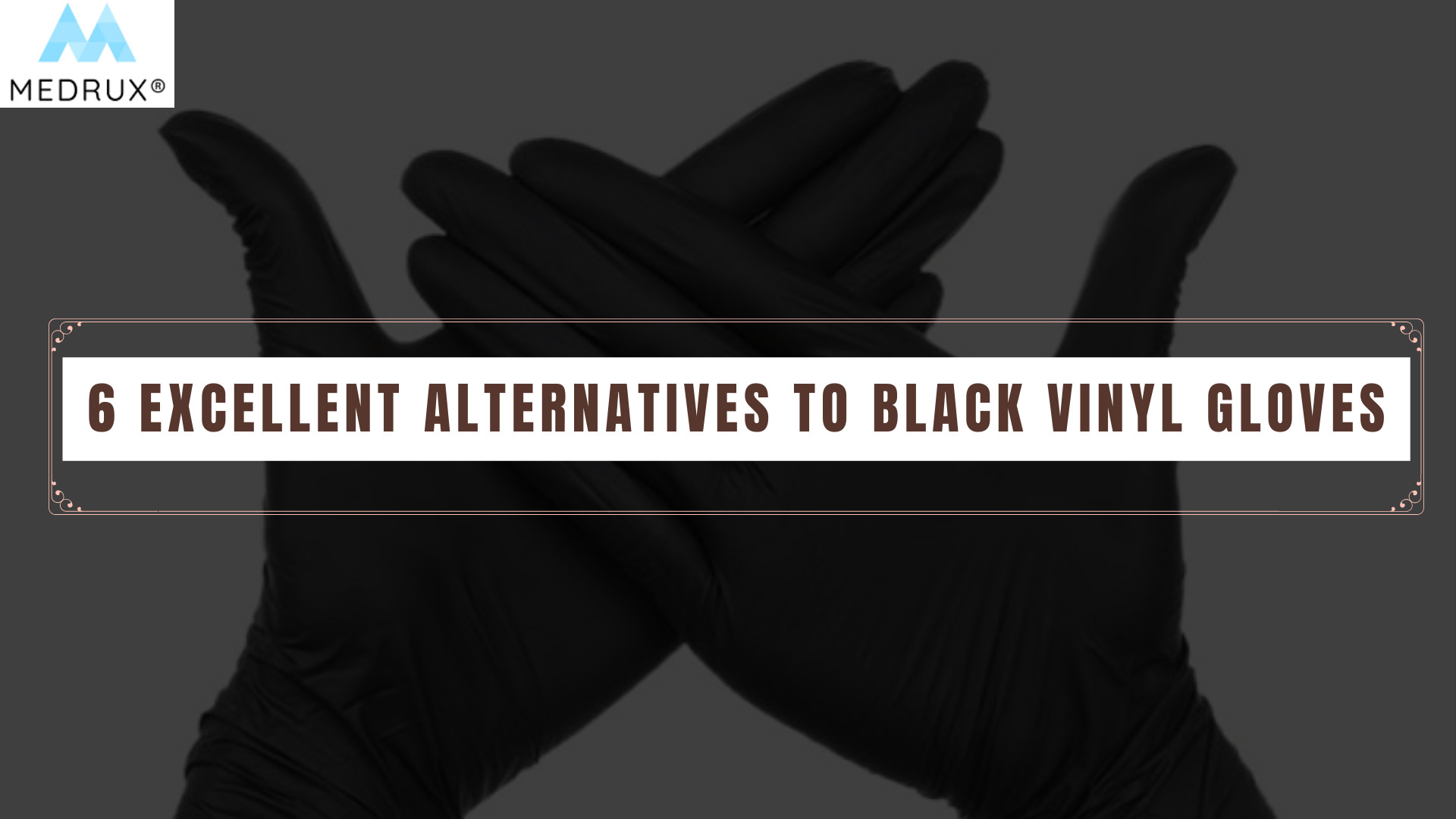Did you finish the perfect portrait using the best colors, and you’re happy about it, but your dirty hands full of paint have another opinion?
Do your fingernails look stained most of the time?
Well, you are most probably in need of painting gloves.
Painters, spray painters, and workers in industrial and construction painting always have pigmented hands with color all over and beneath their fingers.
Painting is a creative process, a vast industry, and many workers’ occupations, and it may seem like a harmless industry with no risks.
However, this is a misconception; there’s specific PPE used for painters and spray painters because of the hazards associated with different painting tasks.
Therefore, protective painting gloves found their way firmly into the world of disposable gloves.
When you get your car sprayed or when you get someone to paint the walls of your new house, you will have one thing in common: they are wearing painting gloves.
Furthermore, many artists now use disposable gloves for painting.
Gloves represent a protective hand barrier against a variety of hazards.
But how many hazards could be the reason for using gloves? And what are the different reasons and situations in these gloves come in handy?
This article will help you know all about painting gloves by discussing the following:
- What are painting gloves, and who should use them?
- How do you choose the best painting gloves? The top ten reasons why you should wear these gloves.
- Painter’s mitt vs. painting gloves
- Is latex suitable for painting tasks?
- Is vinyl suitable for the painting task?
- Why are nitrile gloves the best type of painting gloves?
Let’s begin.
What are painting gloves, and who should use them?
Painting gloves are gloves used while painting to protect your hands against the chemicals, keeping your hands safe and clean at the same time.
In addition to using tiny brushes to paint portraits, canvases, and beautiful paintings, the painting industry has different types of tasks that require gloves, such as:
- Brush painting
This is the simplest and most basic type of paint used for painting wood, window sills, door frames, or simply drawing a beautiful picture using smaller brushes.
Moreover, it can be used for decorative paintings.
- Roller painting
You use a roller to paint the walls and ceilings
- Spray painting
I am using spray guns and machines for industrial painting purposes. This is used for large surfaces, like halls and buildings.
Painting gloves are usually needed for all those types of painting.
Furthermore, they are used for painting-related tasks such as mixing colors, cleaning brushes, and spray guns.
Moreover, they can be used to remove the painting and varnish.
They are also used in industrial painting and coating, such as for spraying cars, applying wood stains, painting industrial floors, and construction painting.
As a result, professional painters, decorators, paint shop technicians, graffiti artists, and others use protective gloves.
The next question is: how can those painting gloves protect us, and why should we use them?
Here are the top ten reasons why you should wear painting gloves.
The top ten reasons why you should wear painting gloves:
-
Painting gloves protect against oils and chemicals
Painters and workers in industrial painting usually work with dangerous chemicals such as solvents, paint strippers, paint thinners, and basecoats.
The paint and paint preparations have various chemicals that shouldn’t be handled without adequately protecting your skin.
Why?
Because these chemicals are harmful to your skin, they could cause dermatitis, skin irritation, and numbness in the areas that come into contact with solvents.
Furthermore, painters usually use lacquer thinners, such as spray guns, as cleaning agents for painting equipment.
These thinners contain organic hydrocarbons that can pass through the skin and enter the body. With repeated exposure, the side effects become more serious, ranging from liver disease to an increased risk of cancer, as indicated by these solvents’ material safety data sheets (MSDSs).
Moreover, some paint pigments contain hazardous materials like cobalt, lead, mercury, barium, chromium colors, and cadmium-based dyes, which can be absorbed through the skin.
That’s why wearing painting gloves is essential to protect your hands against these chemicals and oils.
Are you looking for the best oil-resistant glove options? Click here.
Painting gloves reduce skin contact with paint, pigments, and solvents, which can cause skin damage or staining.
-
Painting gloves are essential in the automotive industry.
Working in the automotive industry entails using automotive coatings at some point.
In other words, car painting.
Spray painters in auto body shops are exposed to many chemicals, especially the isocyanate-based coatings in the sprayed automotive coatings.
This isocyanate-based coating may lead to systemic, respiratory sensitization and occupational asthma upon dermal contact. (1)
In addition, solvents like ketones, acetate, and aromatic hydrocarbons found in precise coat formulations could increase the risk of developing acute and chronic neurological symptoms.
Therefore, wearing painting gloves is highly important to spray painters and workers in the automotive industry.
-
Painting gloves shield your hands from cuts and scrapes
Painters and decorators usually work with sanders and other power tools.
Furthermore, if you’re painting your walls, you’re probably aware that some rubbing down and scraping are required.
This puts your hands at risk of scrapes, lacerations, and cuts.
Painting gloves protect your hands against those risks and injuries.
-
Painting gloves offer a good grip.
The last thing you want when you’re painting the walls of your house is to have the roller brush or the paintbrush slip off your fingers, fall on the floor, and cause splashes and drops everywhere, or have your white canvases splashed with unnecessary colors.
Painters work with many tools, such as brushes, paintbrushes, roller brushes, painting sprays, and paint tubes and palettes.
When working with oily or liquid paints, it is easy for the tools to slip, making control difficult.
Painting gloves offer a good grip on these tools and materials, ensuring they don’t slip out of your fingers and giving you better control.
-
Keeping your hands and fingernails clean
Painting is messy; no matter how careful you are, you can eventually get paint and pigment on your hands and fingernails.
Either when they open that painting tube or pick up a brush handle full of paint.
And no matter how much you scrub them clean, paint can still be on your cuticles for days.
Additionally, oil paints can be tough to get rid of when dried.
Moreover, some kinds of painting, such as pastel painting, require using your fingers.
Imagine always having your fingernails stained; not the prettiest view, right?
Wearing painting gloves keeps your hands clean and dry, ready for whatever daily activity you do next.
Additionally, you can use gloves when washing your brushes to prevent the stains from getting on your hands while rubbing the brushes.
If you are wearing gloves, all you need to do when finished is take them off, rinse your hands with soap and water, and boom, your hands are clean.
-
Painting gloves keep your hands soft and healthy.
After a long day of painting a masterpiece or finishing a shift painting the walls of a new home, you must clean your hands and remove the paint from your clothes.
Oil and acrylic paint are difficult to remove when dried, so you use cleaning solutions and paint thinners to remove the colors on your hands.
However, using harsh detergents, cleaning solutions, and paint thinners is not a good idea as it makes your hands dry and sore most of the time.
Moreover, scrubbing your hands frequently is terrible for your skin, making them rough, dry, and itchy.
It can even crack and blister and become so painful that it could keep you from doing your favorite thing, painting.
In addition, wiping your hands now and then during painting with wipes can also contribute to making your hands drier.
Wearing a painting glove minimizes the use of thinners and harsh cleaning solutions, which helps maintain healthy, soft skin.
-
Painting gloves are great for eczema.
People suffering from eczema and other skin conditions should wear painting gloves.
Why?
Because the paints and oils can easily damage the skin barrier, in addition to the frequent scrubbing to get rid of the colors, which can worsen things.
When you wear gloves, this creates a barrier between your hands and these irritating chemicals, which helps your hands heal and, at the same time, lets you enjoy the painting process without fear of damaging your skin cells or having painful rashes, worsening eczema, or bleeding blisters.
Are you looking for the best gloves for your hand eczema? Click here!
-
Painting gloves keep your place clean.
Transferring a color or type of paint from one surface to another is easy when working with your bare hands and painting.
Imagine painting your wall purple and your hall bright yellow. I don’t suppose you want patches of purple in your yellow hallway.
Painting with gloves will help you avoid this.
Moreover, painting gloves will help you avoid moving the paint from one tool to another.
-
Painting gloves can help you avoid contact dermatitis
Contact dermatitis is common among painters and decorators. (2)
why?
It can result from frequent exposure to chemicals like solvents, acrylates, formaldehyde, epoxy resins, and preservatives.
Painting gloves form a barrier between you and the usual contact with the paint materials that could cause rashes and contact dermatitis.
Additionally, some people have more sensitive skin than others to paints, solvents, and pigmentation.
As a result, people with sensitive skin are strongly advised to wear gloves while painting to avoid flare-ups.
Mentioning contact dermatitis and allergies, we must correct the fact about latex paint and latex allergies.
Latex paint, or “acrylic latex,” is a water-based paint used for walls and ceilings.
This paint is less toxic and more accessible to clean up than oil-based paints.
Moreover, it doesn’t contain any natural latex proteins; hence, it cannot cause a latex allergy. (3)
If you’re worried about working with latex paint and developing a latex allergy, this is not the case here.
However, you should wear painting gloves when working with latex paint because, like with other colors, you could develop contact dermatitis from frequent exposure.
-
Painting gloves help your business grow.
If you work in the painting industry and like to take matters into your own hands, you can paint occasionally or test the colors.
Painting gloves will allow you to have the best of both worlds.
Painters must be connected with their clients, customers, employers, suppliers, and the home office.
Using your phone without it getting all stained, smeared, or corrupted with paint is one key to this.
Meanwhile, looking neat and clean gives your business the best image.
Painting gloves can make your life much easier; you remove them, pick up the phone, or meet with your potential partner or customer.
The bottom line:
Are painting gloves protected against chemicals in painting materials and automotive coatings?
Also, they protect against cuts and tears associated with different painting-related tasks, such as sanding.
Moreover, they keep your hands clean and dry without scrubbing them with thinners; therefore, they help you avoid irritation and skin conditions like contact dermatitis.
They are suitable for people with sensitive skin and skin conditions like eczema.
Finally, they help you keep your workplace clean and presentable when meeting customers and employees.
Now that you know why you should wear painting gloves, let’s look at how to choose them.
How do you choose the best painting gloves?
There are some essential features your painting gloves should have to provide the protection and comfort needed, such as
- Chemical and solvent resistance
- Dexterity and tactile sensitivity
- Size
- Breathability and comfort
- Disposable gloves or reusable gloves?
Let’s go through them.
-
Chemical and solvent resistance
Chemical protection is considered the most critical factor when selecting your painting gloves.
Why?
Chemicals found in paints, spray paints, solvents, and thinners, including acetates, ethylene benzene, toluene, isocyanates, and methyl ethylene ketones, are harmful to your health.
The chemicals in the painting materials differ from one manufacturer to another, and you can always refer to the MSDS sheets for the complete list of the paint ingredients.
Of course, these gloves should offer a protective barrier against many of these toxic chemicals; otherwise, what’s the point of using them?
That’s why nitrile painting gloves are the best for this task.
Nitrile gloves offer chemical resistance against many chemicals, oils, and organic solvents.
However, methyl ethyl ketone (MEK), a potent chemical used in solvents for paints and clean-up, can pass through nitrile gloves.
Therefore, you shouldn’t use nitrile painting gloves when there’s direct contact with MEK for longer than a few minutes.
When working with MEK, you should probably select another type of glove, such as butyl rubber.
However, butyl gloves are not usually used as painting gloves.
Why?
Because they don’t provide the same skill and comfort as nitrile gloves and are more expensive.
-
Dexterity and tactile sensitivity
Skill and the sensitivity of the gloves are so necessary.
Because you need to feel the tools you are working with without compromising protection.
Glove thickness contributes highly to both features and is measured in mils (one-thousandth of an inch).
The thicker the gloves, the more durable and protective they are, yet the less dexterous they feel on your hands.
Furthermore, thicker gloves offer more cut and puncture resistance and, of course, more chemical protection.
Why?
Because they use more materials, creating a more significant barrier for the chemicals to break through.
On the other hand, thinner gloves are more prone to tearing and are less protective, but they provide more excellent dexterity and tactile sensitivity.
Moreover, thinner gloves are more economical and cost-effective.
Usually, gloves with two mils and below are considered thin, gloves above two mils are thicker, and those at 4 or 6 miles and above are considered stale.
14 is the thickest of disposable gloves, meanwhile, and eight is the widest for nitrile gloves.
So, what is the ideal thickness that combines the best of both worlds (protection and tactile sensitivity) in painting gloves?
Painting gloves usually come in 4-, 5-, or 8-mil thicknesses.
Gloves with 4-5 mils are the perfect choice for painting gloves.
They did, however, demonstrate permeation to isocyanates and solvents used in automotive coating and spraying (albeit to a lesser extent than latex).
That’s why, if you’re working in the automotive industry or handling materials that contain isocyanates, you should aim for a higher thickness (8 mils).
Additionally, gloves with an 8-mil thickness are best for industrial painting and heavy-duty vehicle painting tasks requiring extra protection against things like cuts and punctures.
-
Size
What most painters complain about when putting on a pair of gloves is that they are too big, which ruins the process, makes them feel less comfortable, and makes them hate using gloves.
However, the trick is to choose the correct size.
Painting gloves must feel like a second skin, and the tips of the gloves must be completely flush with the advice of your fingers.
Wearing painting gloves that fit your hand correctly is a significant factor when you select your painting gloves.
It takes some trial and error to find the exact perfect size.
My favorite advice is to try it yourself before picking the one that fits.
However, this is not always applicable.
So, go for the brands with a size chart to help you correctly decide and measure.
-
Breathability and comfort
If you work in humid, hot places, your hands can get sweaty and hot.
Furthermore, the spray paint or the tube of metal-pressurized paint can become hot and blister your hands.
Painting gloves protect against heat while maintaining breathability and comfort in hot weather.
Moreover, they keep your hands cool in the summer and warm in the winter.
-
Disposable vs. Reusable
Painting gloves can be reusable or disposable.
Reusable painting gloves are made of synthetic leather or fabrics like nylon or spandex.
They are used mainly for sanding, brushing, scraping, and patching.
You can wash and reuse them, which is less expensive than using multiple disposable ones on the same day.
The best reusable gloves are usually coated with nitrile or polyurethane for better grip.
Meanwhile, disposable gloves are ideal for working with paint thinners and pigments and cleaning your painting tools with mineral spirits or paint thinner.
Keeping all of these factors in mind, let’s learn more about the best types of painting gloves.
-
Painter’s mitt vs. painting gloves
A painter’s mitt is a multilayered, lined glove made of lambswool or fur used by painters to protect their hands while applying paint on oddly shaped surfaces.
They are usually used to replace painting brushes for places that are difficult to reach.
It’s mainly used for painting railings, fences, columns, and staircase spindles.
It offers protection when painting things like coarse wood with splinters.
Unlike disposable gloves, painting mitts can be used as applicators for painting and are commonly used by decorators and for DIY applications.
Although it’s considered a painting glove, it is primarily used in the painting process rather than for chemical protection.
On that note, if you are a professional spray painter working in a paint shop, automotive coating, spraying, or industrial painting, you should get disposable gloves for proper protection.
What are the other types of painting gloves?
-
Is latex suitable for painting gloves?
Latex gloves are made of natural rubber latex. They have exceptional flexibility and can be used in various industries.
However, latex gloves are not a good option for painting task.
Why?
Latex generally has poor chemical resistance; it becomes sticky and degrades quickly when exposed to many chemicals in paint.
Furthermore, they do not prevent the penetration of most solvents.
In addition, they are ineffective when it comes to dangerous chemicals such as isocyanate-based paints used in automotive spraying.
Nevertheless, they can minimize contact with the paint and reduce the clean-up time.
What’s more, latex allergies are something to remember when using latex as painting gloves.
Latex gloves are famous for their latex allergies, which can be in the form of simple red rashes and itchiness or could develop into something more severe like anaphylactic shock.
The bottom line is that although latex gloves can reduce contact time with paintings and keep your hands clean, they are ineffective for chemical protection.
In addition, they can put you at risk of developing latex allergies. So, they are not recommended for painting tasks.
-
Is vinyl suitable for painting gloves?
Vinyl gloves are the most economical gloves out there.
They are cheap, easily found, and, more importantly, easily put on and removed.
Some people use vinyl gloves for painting with acrylic paints, like for hand painting, rather than for protection.
Moreover, they are more resistant to turpentine and other petroleum-based solvents than latex gloves.
They are not very good when using thinning oils or strong solvents.
Additionally, vinyl gloves are loosely fitted; they don’t offer a snug fit around your fingers; hence, they can feel annoying and obstruct your work.
Finally, if they are powdered, there’s a chance that bits of dust can get in your painting if you are not careful with them.
For all these reasons, vinyl gloves are also unfavorable for painting gloves.
This leaves us with one choice for disposable painting gloves: Nitrile
Let’s find out more about them.
-
Why are nitrile gloves the best type of painting gloves?
Nitrile is a petroleum-based synthetic polymer, and it’s considered the most suitable choice for painting gloves.
Why?
It has exceptional chemical resistance to many chemicals, including the ones found in paints and organic solvents (which are some of the harshest chemicals on the gloves)
It resists the mixtures of toluene and hydrotreated naphtha found in thinners.
Moreover, it protects against chemicals such as methanol and hexane, found in lacquer thinner.
Further, they can withstand cleaners, solvents, epoxies, adhesives, oils, and bases, which can all be found in the painting industry.
It’s not only about protection.
Nitrile gloves are famous for their high dexterity and touch sensitivity.
They help you do the job efficiently, feeling like a second skin while keeping you protected.
What’s more impressive is that they are free of latex proteins and, therefore, can be used without fear of latex allergies.
They’re also powder, silicon, and phthalate-free, which means they are hypoallergenic, minimizing the risk of developing rashes and contact dermatitis with frequent use.
Additionally, nitrile gloves offer 4, 5, and 8 mils of thickness, suitable for various painting applications.
They are also cut-, puncture-, and tear-resistant, allowing them to be used in different painting tasks involving heavy machinery or studies involving wood splinters.
Moreover, they have different textured grips for better grip and control over painting tools and equipment.
Finally,
if you care about the environment, there are environmentally friendly nitrile gloves that can biodegrade quickly within biological landfills, thus helping save our ecosystem and contributing less to PPE pollution.
For all those reasons, nitrile gloves are the best painting gloves.
By the end of our article, we hope you have a comprehensive guide to the best type of painting gloves and why you should wear them.
Stay safe from chemicals and enjoy the painting process.
Hajar Nagdy is a microbiologist and a lecturer. Nagdy holds a Bachelor’s degree in the fields of microbiology and environmental sciences, and she is now a M.Sc. candidate in microbiology. In her free time, she can be found listening to classical music, reading interesting scientific articles, running a charity, or traveling across Europe.








